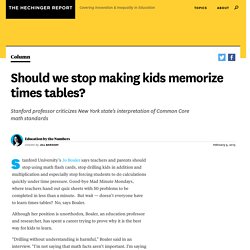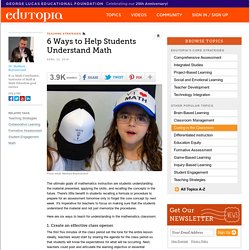

Number Talks 2017#2 - Google Slides. Roger Antonsen: Math is the hidden secret to understanding the world. Knowledge of mathematics learning / Professional learning modules / Professional development / National Standards. Knowledge of mathematics learning is one of a set of professional development modules designed to support school leaders as they lead professional learning about the National Standards for years 1–8 within the New Zealand Curriculum.

The modules are suitable for use during the cycles of professional inquiry that leaders and teachers engage in to improve outcomes for their students. See Knowledge of literacy learning, which is an equivalent module for literacy. Introduction to the module The focus of this module This module focuses on the knowledge of mathematics, and of mathematics teaching and learning, that teachers need in order to work with the mathematics standards for years 1–8. The structure of this module This module has three main sections. Key outcome of the module, which: states what the module aims to help schools leaders and teachers achieve lists indicators that describe what to look for as evidence that they have achieved the outcome provides a rationale for the key outcome. 1. Should we stop making kids memorize times tables? Stanford University’s Jo Boaler says teachers and parents should stop using math flash cards, stop drilling kids in addition and multiplication and especially stop forcing students to do calculations quickly under time pressure.

Good-bye Mad Minute Mondays, where teachers hand out quiz sheets with 50 problems to be completed in less than a minute. But wait — doesn’t everyone have to learn times tables? No, says Boaler. Although her position is unorthodox, Boaler, an education professor and researcher, has spent a career trying to prove why it is the best way for kids to learn. “Drilling without understanding is harmful,” Boaler said in an interview. In a new working paper, “Fluency Without Fear: Research Evidence on the Best Ways to Learn Math Facts,” updated and published online on January 28, 2015, Boaler argues that many common math teaching tools — flash cards, math sprints and repetitive worksheets — are not only unhelpful, but also “damaging.” Boaler’s argument has several parts. How A Strengths-Based Approach to Math Redefines Who Is “Smart” A group of young women who had graduated from high school between 1997 and 2006 sat at the front of the room crying and laughing about their experiences learning math at Railside High (a research pseudonym for the school).

This session of the National Council of Teachers of Mathematics annual meeting didn’t focus on any specific mathematical practice and yet it was enlightening — with the right approach, teachers can help kids who hate math feel like it’s their best subject. One after another, these young women, who had all graduated from an urban high school serving many kids living in poverty, described how math class made them feel safe, heard and able to express their ideas without fear.
“I felt like they cared for me,” said Martha Hernandez, who graduated in 2002 and is now a social worker. Modeling With Mathematics. Modeling with mathematics is the practice of making sense of the world through a mathematical perspective.

Take a moment to look around and get curious: How do you use mathematics to make decisions in your everyday life? Maybe you’re deciding what to make for dinner. Does the recipe have enough servings to feed everyone or will you need to modify it, perhaps by doubling or halving the amount of each ingredient? When should you start making dinner if you’d like to eat at 6? These questions can be viewed from a mathematical perspective. Children also need opportunities to identify mathematical problems in their world, determine what information will help them solve a problem, develop mathematical models of situations, and revise their models to more closely predict real world phenomena. Three-Act Tasks. Math Journals As Formative Assessment. I’m a huge fan of writing in math class!

While I was teaching, I had my 5th graders write in their math journals every single day. Whether they used the journals before the lesson to write down estimations, during class to show their reasoning through a problem, or at the end of class for an exit prompt, the journals were always a safe and not-graded place for students to jot down their thoughts. No matter the prompt, I always learned so much about what they understood by reading their entries each day. This year, as a math specialist, I get to see student writing in math classes across many grade levels, and it’s so incredibly interesting. I’m able to see where it all begins, in kindergarten, before students are even writing explanations in words, to 5th grade, where the writing becomes very articulate. The Commutative Property The majority of students chose two expressions demonstrating the commutative property of multiplication. 16 x 2 = 2 x 16 8 x 4 = 4 x 8 Rearranging the Groups. 6 Ways to Help Students Understand Math.
The ultimate goals of mathematics instruction are students understanding the material presented, applying the skills, and recalling the concepts in the future.

There's little benefit in students recalling a formula or procedure to prepare for an assessment tomorrow only to forget the core concept by next week. It's imperative for teachers to focus on making sure that the students understand the material and not just memorize the procedures. Here are six ways to teach for understanding in the mathematics classroom: 1.
Create an effective class opener. Drpaulswan. Educational Leadership:Teaching for Meaning: Teach Mathematics Right the First Time. Assessing students’ maths self-efficacy and achievement.